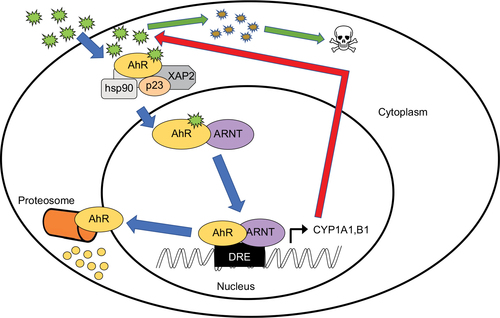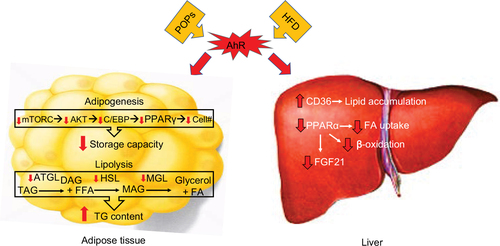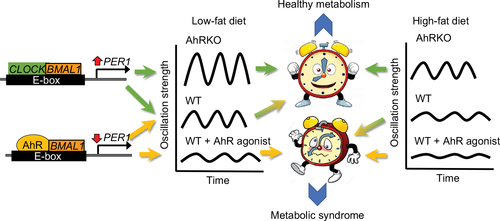Figures & data
Figure 1 Canonical AhR signaling pathway.
Abbreviations: AhR, aryl hydrocarbon receptor; POPs, persistent organic pollutants; ARNT, aryl hydrocarbon nuclear transporter; DRE, dioxin response element.

Figure 2 AhR regulates body metabolism through actions in the liver and adipose tissue.
Abbreviations: AhR, aryl hydrocarbon receptor; POPs, persistent organic pollutants; mTORC, mammalian target of rapamycin complex; PPAR, peroxisome proliferator-activated receptor; HFD, high-fat diet; FA, fatty acid; FGF21, fibroblast growth factor 21; C/EBP, CCAAT/enhancer-binding protein; ATGL, adipose triglyceride lipase; DAG, diacylglycerol; HSL, hormone-sensitive lipase; MAG, monoacylglycerol; MGL, monoglyceride lipase; TG, triglycerides; FFA, free fatty acids; TAG, triacyl glycerol.

Figure 3 A healthy circadian clock maintains synchronization of central and peripheral rhythms with the external environment resulting in metabolic homeostasis. AhR can compete with CLOCK to form heterodimers with the clock gene, BMAL1. Although CLOCK/BMAL1 act as activators on the E-box of the PER promoter, AhR/BMAL1 suppresses activity at the E-box. Thus, removal of AhR enhances CLOCK/BMAL1 activity and increases the amplitude of circadian oscillations. When AhR is present, rhythm amplitude is slightly dampened by endogenous activation of AhR. In the presence of AhR agonists, AhR/BMAL1 activity dominates at the E-box, thereby further dampening the rhythm. HFD can also dampen rhythms, which are strongly associated with metabolic dysfunction. Thus, activation of AhR and HFD interacts to compound the detrimental effects on metabolism. AhR depletion protects against the detrimental effects of HFD by promoting rhythm amplitude and maintaining a healthy clock.

